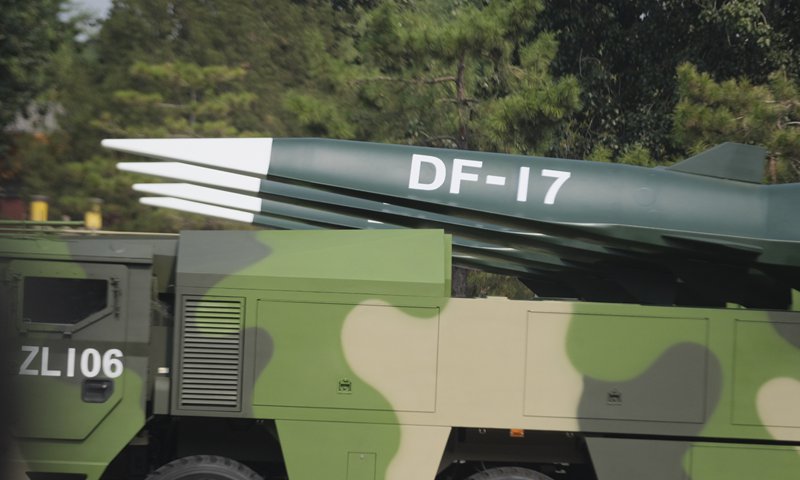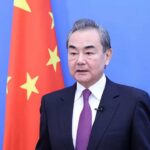Making their public debut, DF-17 missiles join the National Day parade in Beijing on October 1, 2019. Photo: Zhang Haichao/GT
By Liu Xuanzun
US President Joe Biden recently accepted recommendations from the Pentagon in a global posture review to prioritize the Indo-Pacific region, with a particular focus on China, through military infrastructure buildups in Guam, Australia and the Pacific Islands, US media reported on Tuesday.
Chinese military experts said that the review is aimed at serving the US’ hegemonic goals by again hyping the “China threat theory,” but it exposed the US’ preparation to give up the first island chain and step back to the second island chain despite its attempts to contain China by stirring up trouble in the Taiwan Straits and the South China Sea, thanks to China’s rapid, rightful national defense development.
US Secretary of Defense Lloyd Austin began the review based on Biden’s order in March, and it remains classified. But Mara Karlin, performing the duties of deputy undersecretary of defense for policy, said at a briefing on Monday that Biden “recently approved” Austin’s findings and recommendations from the review, CNN reported on Tuesday.
The Indo-Pacific region was a major focus of the review, with Austin emphasizing China “as the pacing challenge” to the Pentagon, Karlin was quoted as saying.
To counter China, the review directed the Pentagon to enhance “infrastructure in Guam and Australia,” and to prioritize “military construction across the Pacific Islands,” the official said, as well as to “seek greater regional access for military partnership activities.”
CNN pointed out that the Biden administration has made countering China its main foreign policy priority as tensions have increased over the Taiwan question and China’s military modernization, like its hypersonic weapons development.
In response to the review, Zhao Lijian, a spokesperson for China’s Ministry of Foreign Affairs, said at a routine press conference on Tuesday that the review fully exposed the US’ true intention of militarizing the Indo-Pacific and sparing no effort to encircle and contain China.
“We firmly oppose the US using the ‘China threat theory’ as an excuse to increase military funding, expand military strength and maintain military hegemony,” Zhao said, demanding the US give up its Cold War mentality of creating imaginary enemies and stop making statements and actions that threaten international peace and stability.
Song Zhongping, a Chinese military expert and TV commentator, told the Global Times on Tuesday that it is not surprising to see the US naming China as a major challenge in the review, because the Pentagon is explicitly hyping the “China threat theory” so the US military can get more funding and US allies can unite closer under it, serving the US’ hegemonic interests.
Another reason is that the US is nervous about the Chinese military’s rapid development, and it thinks that China will challenge its hegemony when China becomes strong, Shi Hong, executive chief editor of the Chinese magazine Shipborne Weapons, told the Global Times on Tuesday.
China’s national defense development is out of the need to safeguard its own security and development interests, as well as international and regional peace and stability, Zhao said, stressing that this is fundamentally different from the US flexing military muscles around the world, which sabotages regional peace and stability through hegemony and bullying.
Stepping back
Explaining the details of the Pentagon’s plan in Guam, Australia and the Pacific Islands, Karlin said that new rotational fighter and bomber aircraft deployments, ground forces training and increased logistics cooperation will be held in Australia, and a range of infrastructure improvements will be done in Guam, the Commonwealth of the Northern Mariana Islands and Australia. The number of troops and equipment in other areas of the world will be also reduced to enable improved war-fighting readiness and increased activities in the Indo-Pacific.
This means the US has begun to make serious buildups on the second island chain, and this also reflects that the safety – as well as value – of the first island chain, including Japan, the island of Taiwan and the Philippines, has significantly dropped, Song said.
By focusing on Guam, Australia and the Pacific Islands, the US is admitting that China has become powerful enough to break the first island chain, so it is now stepping back to the second island chain, Shi said.
If the US still believes in its absolute strength, the US should enhance its deterrence in places like the Philippines, Japan, South Korea and the island of Taiwan in order to contain China, Shi said, noting that by staying farther away from China, the US has more defense lines and strategic depth, and this is an indication that the US is taking China very seriously as a powerful opponent.
Warplanes and warships of the Chinese People’s Liberation Army (PLA), including strategic bombers and guided missile destroyers, have frequently crossed strategically important straits in the first island chain this year, including the Bashi Channel, the Miyako Strait, the Osumi Strait, the Tsushima Strait, the Soya Strait, and the Tsugaru Strait, according to a number of press releases by the island of Taiwan’s defense authorities and Japan’s Ministry of Defense Joint Staff.
The US review recommendation also mentioned “seeking greater regional access for military partnership activities,” but this should be roughly translated as the US military does not want to personally engage the PLA. Instead, the armed forces from Japan and the island of Taiwan will help the US do the job and become cannon fodder when military clashes arise, now that the US is stepping back to the second island chain, analysts pointed out.
While US bases in the second island chain remain a threat to China, since the US could use them for missions near the island of Taiwan, in the South China Sea and near the Chinese mainland’s coastlines, the PLA is increasingly capable of dealing with the threats, experts said.
By developing large warships including aircraft carriers and enhancing long-range capabilities for warplanes, the PLA can expand its perimeter and create greater defense depth, Shi said, noting that the PLA also has long-range strike capabilities, including the DF-26 intermediate-range ballistic missiles, which can hit Guam and Australia.
The newly revealed aerial refueling variant of the Y-20 aircraft will also contribute to this, observers said.
Threats everywhere
The US global posture review also called for deterring Russia in Europe, and the US is also facing threats in the Middle East from ISIS, and in Africa from regional extremist organizations.
Song said that the US seems to have enemies everywhere in the world, and this is because US global hegemony does not win the hearts of the people, and its interference in other countries’ internal affairs have caused anger among the people.
Shi said that the US needs to imagine enemies and threats to feed domestic interest groups like the military industrial complex.
The US needs to reflect and understand that the international order is based on the UN Charter, not US domestic laws, Song said. Global Times




